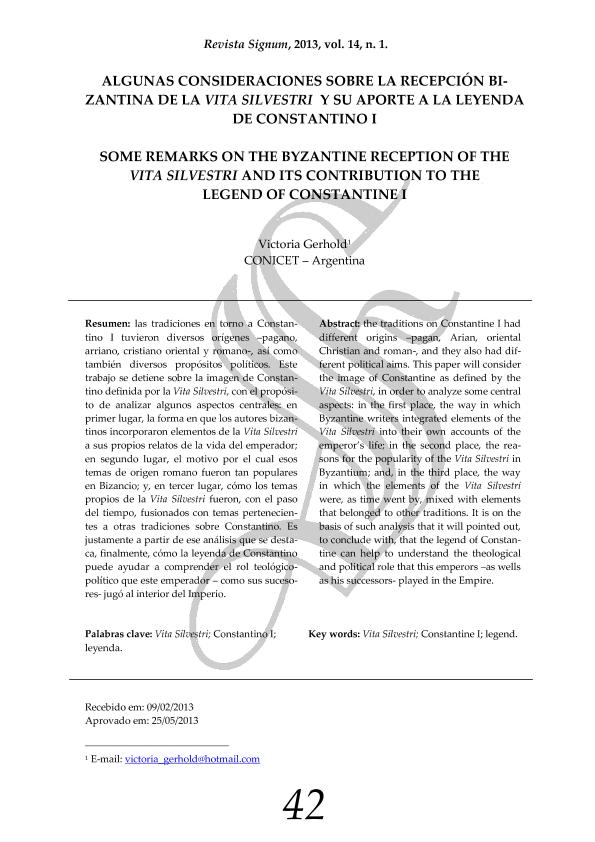Mostrar el registro sencillo del ítem
dc.contributor.author
Casamiquela Gerhold, Victoria Errain

dc.date.available
2016-02-11T14:25:11Z
dc.date.issued
2013-05
dc.identifier.citation
Casamiquela Gerhold, Victoria Errain; Algunas consideraciones sobre la recepción bizantina de la Vita Silvestri y su aporte a la leyenda de Constantino I; Associação Brasileira de Estudos Medievais; Signum; 14; 1; 5-2013; 30-41
dc.identifier.issn
1516-6295
dc.identifier.uri
http://hdl.handle.net/11336/4133
dc.description.abstract
Las tradiciones en torno a Constantino I tuvieron diversos orígenes (pagano, arriano, cristiano oriental y romano), así como también diversos propósitos políticos. Este trabajo se detiene sobre la imagen de Constantino definida por la Vita Silvestri, con el propósito de analizar algunos aspectos centrales: en primer lugar, la forma en que los autores bizantinos incorporaron elementos de la Vita Silvestri a sus propios relatos de la vida del emperador; en segundo lugar, el motivo por el cual esos temas de origen romano fueron tan populares en Bizancio; y, en tercer lugar, cómo los temas propios de la Vita Silvestri fueron, con el paso del tiempo, fusionados con temas pertenecientes a otras tradiciones sobre Constantino. Es justamente a partir de ese análisis que se destaca, finalmente, cómo la leyenda de Constantino puede ayudar a comprender el rol teológico-político que este emperador -como sus sucesores- jugó al interior del Imperio.
dc.description.abstract
The traditions on Constantine I had different origins –pagan, Arian, oriental Christian and roman-, and they also had different political aims. This paper will consider the image of Constantine as defined by the Vita Silvestri, in order to analyze some central aspects: in the first place, the way in which Byzantine writers integrated elements of the Vita Silvestri into their own accounts of the emperor’s life; in the second place, the reasons for the popularity of the Vita Silvestri in Byzantium; and, in the third place, the way in which the elements of the Vita Silvestri were, as time went by, mixed with elements that belonged to other traditions. It is on the basis of such analysis that it will pointed out, to conclude with, that the legend of Constantine can help to understand the theological and political role that this emperors –as wells as his successorsplayed in the Empire.
dc.format
application/pdf
dc.language.iso
spa
dc.publisher
Associação Brasileira de Estudos Medievais
dc.rights
info:eu-repo/semantics/openAccess
dc.rights.uri
https://creativecommons.org/licenses/by-nc-sa/2.5/ar/
dc.subject
Vita Silvestri
dc.subject
Constantino I
dc.subject
Leyenda
dc.subject
Santidad Imperial
dc.subject.classification
Historia

dc.subject.classification
Historia y Arqueología

dc.subject.classification
HUMANIDADES

dc.title
Algunas consideraciones sobre la recepción bizantina de la Vita Silvestri y su aporte a la leyenda de Constantino I
dc.title
Some remarks on the byzantine reception of the Vita Silvestri and its contribution to the legend of Constantine I
dc.type
info:eu-repo/semantics/article
dc.type
info:ar-repo/semantics/artículo
dc.type
info:eu-repo/semantics/publishedVersion
dc.date.updated
2016-03-30 10:35:44.97925-03
dc.identifier.eissn
2177-7306
dc.journal.volume
14
dc.journal.number
1
dc.journal.pagination
30-41
dc.journal.pais
Brasil

dc.journal.ciudad
Belo Horizonte
dc.description.fil
Fil: Casamiquela Gerhold, Victoria Errain. Consejo Nacional de Investigaciones Científicas y Técnicas. Oficina de Coordinación Administrativa Saavedra 15. Instituto Multidisciplinario de Historia y Ciencias Humanas; Argentina
dc.journal.title
Signum

dc.relation.alternativeid
info:eu-repo/semantics/altIdentifier/url/http://www.abrem.org.br/revistasignum/index.php/revistasignumn11/article/view/87
dc.relation.alternativeid
info:eu-repo/semantics/altIdentifier/issn/2177-7306
Archivos asociados
